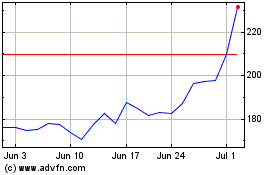By Gautham Nagesh
Future buyers of General Motors Co.'s semiautonomous driving
system will have to be comfortable with Big Brother sitting in the
passenger seat.
The nation's largest auto maker aims to release its Super Cruise
on a Cadillac next year, and will feature eye tracking in the
cabin, a first for a U.S. car maker.
GM will duel with Volvo Car Corp.'s Pilot Assist and Tesla
Motors Inc.'s Autopilot, both driver-assistance systems that can
control a moving vehicle. While Tesla's Autopilot requires periodic
handling by the driver, GM's system is expected to go a step
further in monitoring the alertness of human drivers.
Super Cruise's 2017 launch will come amid heightened scrutiny of
systems that use cameras, sensors or radar to let the car do much
of the driving at higher speeds. A fatal accident in May involving
Tesla's Autopilot raised questions over how well these technologies
work and whether consumers understand their limitations.
GM's Super Cruise software can detect if a driver is dozing off
or not watching the road, and uses audible and visual alerts to
grab the person's attention. If the alerts don't work, a
representative with the auto maker's OnStar information service
will activate the vehicle's intercom and communicate with the car's
operator. If the driver still doesn't respond, the car will pull
over on the side of the freeway and stop.
The Detroit car maker, which has been testing the eye-tracking
feature for a couple of years, hopes to be ahead of its domestic
competitors and cater to consumers who increasingly are looking for
automated driving-assistance features. GM hasn't said what the
option will cost.
In a recent interview, Mark Reuss, GM executive vice president
for global product development, said the current way some auto
makers monitor alertness -- by requiring periodic touching of the
steering wheel -- isn't sufficient because "you can defeat the
hands-on-the-wheel devices pretty readily." That is why GM "will
use something that's pretty hard to get around," he said.
OnStar, launched in the 1990s as a concierge service, has taken
on more communication functions as GM's cars have become more
connected via embedded Wi-Fi connections and integration with
smartphones. Super Cruise will be an option that requires OnStar
services, the auto maker said.
GM had planned to launch Super Cruise earlier, but the program
was delayed for several reasons, including fine-tuning the
interface drivers use to connect with the system. Mr. Reuss said
one of the goals has been to refine the way drivers interact with a
semiautonomous system.
Super Cruise's extra layer of supervision will address concerns
harbored by regulators and industry participants about a driver's
tendency to not pay attention when a semiautonomous driving aid is
active.
German auto makers including Audi, the luxury-car unit of
Volkswagen AG, are also expected to launch eye-tracking systems in
the near future. Suppliers of the technology expect regulators to
eventually require them in all car models.
U.S. Department of Transportation officials have said that
despite concerns about driver behavior, systems such as Tesla's
Autopilot can reduce highway fatalities. Certain semiautonomous
features will soon be required, and regulators have encouraged auto
makers to proceed aggressively.
But such systems also raise privacy concerns, particularly if
auto makers retain driver data that could be passed along to
insurance companies or public safety authorities without
permission.
A GM spokesman said the auto maker collects personal data
through OnStar from customers who purchase the service, but only
shares that information with the car owner's consent.
Chris Calabrese, policy head at the Center for Democracy and
Technology, a Washington, D.C., group that advocates for consumer
privacy protections, said car companies should not progress at the
expense of privacy. He said auto makers have shown "intent" to
protect privacy, but said "they have to get it right."
As more data is gathered, Mr. Calabrese recommends that auto
companies delete driver data soon after it is collected rather than
compile a continuous record.
Auto-parts maker Delphi Automotive PLC, once a unit of GM, is a
developer of eye-tracking systems, which are designed to work even
when the driver's head is obscured by, say, sunglasses or a ball
cap. The system reads the eye socket and nose to determine whether
the driver is alert and looking at the road; if not, audible
warnings, lights or vibration are used to prod the person.
More driver monitor tools are on the way. Modar Alaoui, founder
and chief executive of Silicon Valley startup Eyeris Technologies
Inc., said his company produces software that also monitors head
position, body orientation, yawning, and even emotional well-being.
The company's software is tuned to work on cars with relatively old
cameras or processors.
Mr. Reuss said driver monitoring is one piece of GM's approach
to a safer self-driving platform. He said Super Cruise will be
limited to highways that have detailed map information available;
if the driver leaves the highway, Super Cruise shuts down.
"It can't go everywhere," he said.
Write to Gautham Nagesh at gautham.nagesh@wsj.com
(END) Dow Jones Newswires
September 09, 2016 05:45 ET (09:45 GMT)
Copyright (c) 2016 Dow Jones & Company, Inc.
Tesla (NASDAQ:TSLA)
Historical Stock Chart
From Mar 2024 to Apr 2024

Tesla (NASDAQ:TSLA)
Historical Stock Chart
From Apr 2023 to Apr 2024
